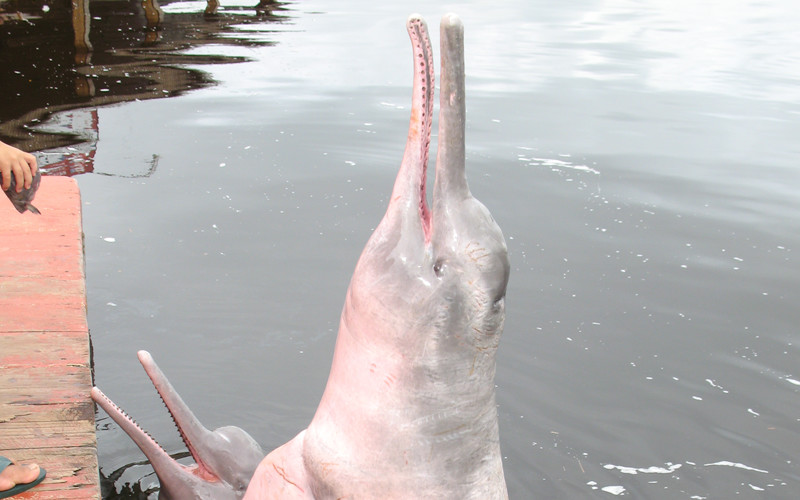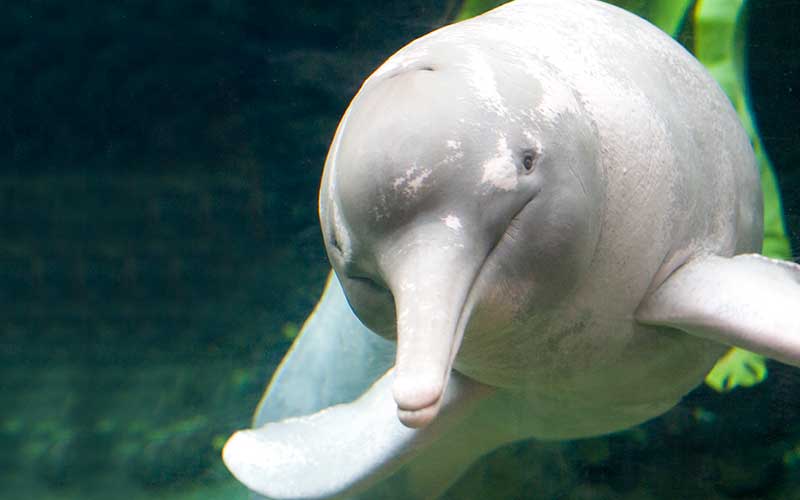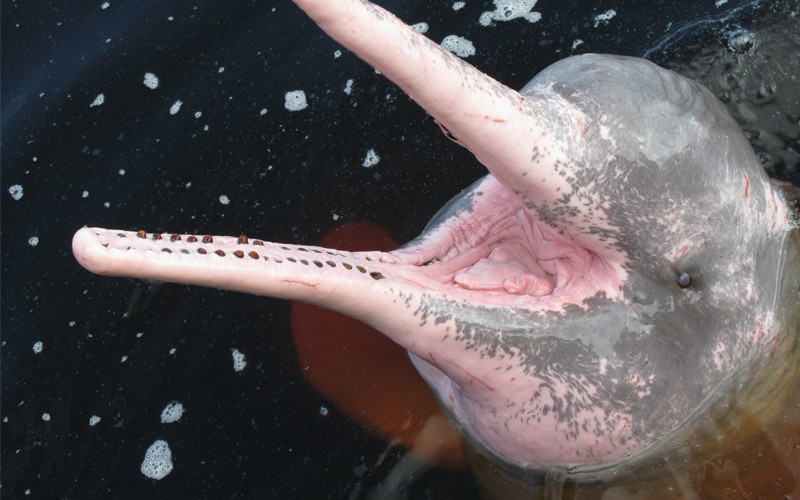Amazon River Dolphin Facts
(Inia Geoffrensis)
INFORMATION AND CHARACTERISTICS.
Other common names of this dolphin are Boto, bufeo and pink river dolphin. Among the river dolphins, this species is the largest, best known, most researched and with the largest population. There are three subspecies of Amazon river dolphin:
– Inia geoffrensis geoffrensis.*
– Inia geoffrensis humboldtiana.
– Inia geoffrensis boliviensis.
* Recently (2014) this subspecies was split from Inia geoffrensis and defined as an independent species with the name Araguaian River dolphin as mitochondrial studies determined that they are indeed different species.
HOW DO THEY LOOK? PHYSICAL CHARACTERISTICS.
Morphology.
It is a robust dolphin with a very long snout easily distinguishable. It has a bulbous forehead due to a pronounced melon, chubby cheeks, small eyes and a remarkably flexible neck since its vertebrae are not fused. The pectoral flippers are large and have a triangle shape. He has a heterodont denture since his teeth are conical in the front of the jaw while the back pieces have a flange.
Order: Cetacea
Superfamily: Inioidea
Family: Iniidae
Genus: Inia
Weight and size.
Adults are between 1.53 and 2.4 meters in length, but this depends on the subspecies in question. The largest individual recorded was a female, weighing 98.5 kilograms.
Skin Coloration.
The most distinctive feature of this dolphin is the pink color that it acquires with age. The lower part of the body is usually clearer, and some individuals have gray patches.
Distinctive characteristic.
It is the only species of cetacean with heterodont dentition, and its dorsal fin is so small that it rather looks like a triangular crest.

Amazon River Dolphin – Inia Geoffrensis.
WHERE DO THEY LIVE? DISTRIBUTION AND HABITAT.
The Amazon River dolphin inhabits only the freshwater systems of South America. Its distribution includes the basins of the Amazon and Orinoco rivers and the tributaries of these rivers in Bolivia, Colombia, Brazil, Ecuador, Peru, and Venezuela. However, each subspecies lives in defined areas: I. g. Geoffrensis thrives in the Amazon and Araguaia river basins except for the upper Teotonio rapids in the Madeira river basin in Bolivia. I.g. Boliviensis inhabits above the Teotonio rapids in the basin of the Amazon River and, I. g. Humboldtiana dwells in the basin of the Orinoco River.
The Amazon River dolphin can live in areas of slow movement, in deep water channels, in flooded forests, in confluences where clear waters and sewage mix, in narrow channels and possibly under waterfalls and rapids.
WHAT DO THEY EAT? DIET AND EATING HABITS.
The Amazon pink dolphin consumes a variety of prey more diverse than other species of dolphins. Fish, crabs and small turtles are part of the diet of this cetacean that regularly hunts alone and consumes 2.5 percent of its total weight each day.
The diet of these dolphins includes 43 species of fish. Their favorite fish belong to the families Sciaenidae, Cichlidae, and the one of the feared piranhas, Serrasalmidae.
It is a natural hunter. Mostly active during the day, it knows that under the waterfalls or at the mouths of the rivers, it is easier to catch the fish that pass through the currents. Sometimes it looks for food at the riverbed. The hard shells of turtles do not deter this dolphin from eating these reptiles because for such prey it has a potent and long “snout” that helps break the hard parts.
Sometimes it associates with the giant otter (Pteronura brasiliensis) or the tucuxi (Sotalia fluviatilis) to hunt in a coordinated way and share the food.
HOW DO THEY BEHAVE? BEHAVIOR
Observations concluded that the Amazon River dolphin moves slowly. Its speed while swimming is only 1.5 to 3.2 kilometers per hour, but it has occasional bursts reaching up to 14 to 22 kilometers per hour.
It is not as sociable as the oceanic dolphins since it usually travels in groups of 2 or 3 individuals, mostly mothers with a calf. It is, therefore, a lone dolphin. The larger groups, with 12 to 15 members, are temporal associations with the purpose of feeding or mating.
It is somewhat shy with humans, but sometimes it shows curiosity. It is also very playful, and it has been seen pulling the aquatic grass and throwing pieces of wood. Curiously, at times its food is also its friend: it usually plays with fish and turtles.
It uses echolocation to perceive what is in its environment and capture prey. The “clicks” are the basis of their communication and reach from 16 to 170 kilohertz.

HOW DO THEY REPRODUCE? MATING AND REPRODUCTION.
Scientists believe that this species is monogamous, but after noticing the male’s aggressiveness during mating and the multiple scars on its body, they began considering the idea of polygamy because this is the evidence of a possible competition for females.
Males and females reach sexual maturity at about five years of age or when the former is already about 2 meters in length, and the latter is between 1.60 and 1.75 meters. When a male finds a receptive female, he communicates his mating intentions by biting the female’s flippers.
11 months after mating, a single offspring is born between May and July measuring about 0.8 meters long. The time between each birth can last up to 5 years.
WHAT IS THEIR CONSERVATION STATUS? THREATS AND CONSERVATION.
Conservation Status: Data Deficient.
The fact that the pink dolphin has a “Data Deficient” conservation status on the Red List of the International Union for the Conservation of Nature entails a danger not completely unknown, but that makes difficult to implement conservation strategies. It is evident that the species faces a serious problem for survival in its natural habitat and until 2011 had a classification as a vulnerable species.
Their principal anthropogenic threats are:
– Overfishing.
This practice reduces the availability of food for the species.
– Dam construction.
The development of hydroelectric dams in the river, alter the conditions of their habitat separating populations which reduce the availability of mating partners and the genetic diversity.
– Uncontrolled logging.
When logging for converting the forests into agricultural land, the number of animals consuming the products of the trees decreases, and the amount of food for the Boto reduces in consequence.
– River traffic.
Excessive boat traffic causes collisions with these dolphins where the propellers cause them serious injuries.
– Habitat pollution.
The increasing contamination of the river brings all kind of problems to these dolphins and reduces their chances to survival drastically.
In their natural habitat, alligators, jaguars, anacondas and Bull sharks (Carcharhinus leucas) are their major threats. In Brazil, Peru, Venezuela, Colombia and Bolivia, there are laws to protect this species. Since 1986, the Cetacean Specialist Group of the Species Survival Commission has been working to protect and design conservation strategies for all endangered river dolphins.
Amazon River Dolphin Infographic!
(Click for expand)
References
Annalisa Berta. Whales, Dolphins, and Porpoises: A Natural History and Species Guide. University of Chicago Press, 2015.
William F. Perrin, Bernd Würsig, J.G.M. ‘Hans’ Thewissen. Encyclopedia of Marine Mammals. Academic Press, 2009. Page 26
Sy Montgomery. Journey of the Pink Dolphins: An Amazon Quest. Chelsea Green Publishing, 2009.
http://www.iucnredlist.org/details/10831/0
http://ufdc.ufl.edu/UFE0046251/00001


